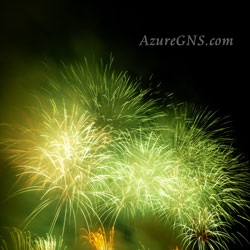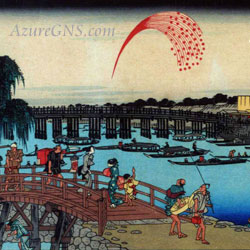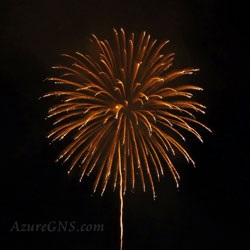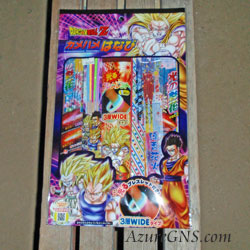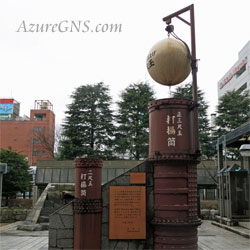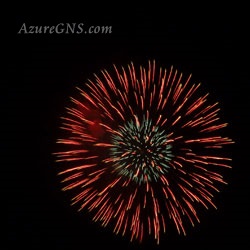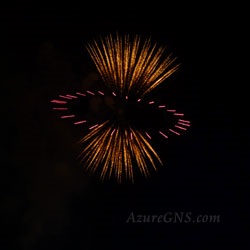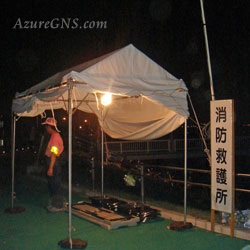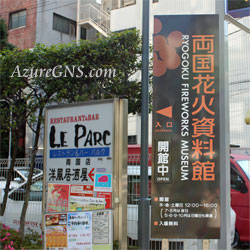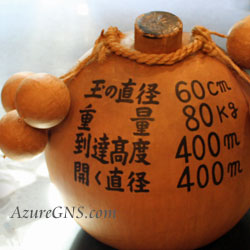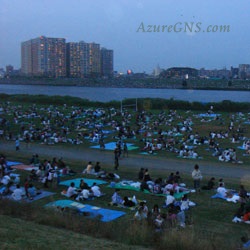(7月-8月)
Hanabi;
Fireworks
(from July to August)
●花火 Hanabi; fireworks(通例複数形)
●花火大会 firework(s) display; firework(s) exhibition; firework(s) show
●花火師 pyrotechnist; fireworks expert
●打ち上げ花火 rocket; skyrocket
●仕掛け花火 set fireworks; a set piece of fireworks
●手に持つ花火 (toy) sparkler
●線香花火 sparkling fireworks; toy fireworks
●花火を打ち上げる (to) set off fireworks; (to) shoot off fireworks; (to) let off fireworks
●花火工場 fireworks factory
●花火師 fireworks manufacturer
●爆竹 firecracker
●のろし signal fire; beacon; bonfire
●のろしを上げる (to) make a signal fire
◆花火の起源は中国ののろしだと言われています。
The origin of fireworks is said to be from signal fires in China.
◆その後シルクロードを通ってヨーロッパに渡り大きく発展したといわれています。
Later, fireworks from China were introduced to Europe via the Silk Road, and they became more developed.
◆日本の花火の歴史は1549年(天文18年)の鉄砲伝来の際、火薬が日本に入ってから始まりました。
The history of fireworks in Japan started in 1549 (Tembun 18th yr), when guns and gunpowder were introduced into Japan.
◆古くは江戸幕府初代将軍徳川家康が江戸城内で花火を見物したという記録が残っています。
It was recorded that Tokugawa Ieyasu, the first Shogun of the Edo Government, saw fireworks from Edo Castle.
◆江戸時代(1603-1868)に花火師達が命がけでその技を磨きました。
Fireworks manufacturers improved their skills at the risk of their lives during the Edo period (1603-1868).
◆日本で現存する最も由緒ある花火屋は鍵屋です。
Kagi-ya is the most historic fireworks factory existing in Japan today.
◆鍵屋の手代が暖簾分けして開いた花火屋が「たまやー」の掛け声で有名な玉屋です。
The salesclerk for Kagi-ya’s fireworks manufacturer was allowed to set up his own fireworks factory called Tama-ya, which is now immortalized by the calls of the crowds, “Tama-ya!” (The onlookers of fireworks display often shout “Tama-ya!” in place of applause.)
◆一時玉屋は鍵屋をしのぐ人気でした。
Tama-ya was more popular than Kagi-ya for a time.
◆しかし玉屋は大火を出して一代限りになりました。
However, Tama-ya was compelled to close its business because a big fire broke out in the factory.
◆現在は「たまやー」同様「かぎやー」の掛け声が残っています。
The call of “Kagi-ya!” exists now, as well as the call of “Tama-ya!”
◆明治時代(1868-1912)になり、日本の花火師は西洋方式を取り入れ、技術を磨き続けました。
In the Meiji period (1868-1912), Japanese fireworks manufacturers adopted the Western method of creating fireworks, and were constantly improving their techniques.
◆日本の花火師は世界の花火製品の中でも有数の技術の高さと独創性を誇っています。
Japanese fireworks manufacturers are proud of their high level of skill and originality in the world’s fireworks production.
◆花火はおもちゃ花火、打ち上げ花火、仕掛け花火と大きく三種類に分けることができます。
There are three kinds of fireworks: toy fireworks, rocket fireworks and set fireworks.
◆おもちゃ屋、スーパー、コンビニなどで売っている家庭用の花火がおもちゃ花火です。
Toy fireworks are sold at such places as toy shops, supermarkets, and convenience stores, for family use.
◆代表的なものには線香花火、ロケット花火、ねずみ花火があります。
The most popular fireworks are senko-hanabi (sparklers), rokketo-hanabi (rocket fireworks), and nezumi-hanabi (mouse fireworks).
◆夜空を彩る打ち上げ花火は特に夏の風物詩として人気があります。
Fireworks, which beautifully decorate the night sky, are a very popular attraction, especially as a summer event.
◆全国の地方自治体の多くが年1回の花火大会を主に7月または8月に開催します。
Many local governments throughout Japan hold annual fireworks displays, mainly in July and August.
◆有名な花火大会は大阪府のPL花火大会、新潟県の長岡まつり花火大会、茨城県の土浦全国花火競技大会などです。
The famous fireworks displays are PL Hanabi-taikai (the PL Fireworks Display) in Osaka Prefecture, Nagaoka Matsuri Hanabi-taikai (the Nagaoka Festival Fireworks Display) in Niigata Prefecture, and Tsuchiura Zenkoku Hanabi Kyogi-taikai (the Tsuchiura National Fireworks Competition) in Ibaraki Prefecture.
◆東京都の隅田川花火大会は戦争や交通事情の悪化で何度か中断しましたが、江戸時代から続いています。
Sumida-gawa Hanabi-taikai (The Sumida River Fireworks Display) in Tokyo has been held since the Edo period, with some interruptions due to wars and traffic deterioration.
◆テーマパークでは年中、花火が打ち上げられることがあります。
Fireworks displays are held throughout the year in some theme parks.
◆打ち上げ花火の有名なものとして菊、牡丹、しだれ柳、しだれ桜、椰子、蝶々などが挙げられます。
The best-known rocket fireworks are kiku (chrysanthemum), botan (peony), sidare-yanagi (weeping willow), sidare-sakura (drooping cherry tree), yashi (palm tree), and chocho (butterfly).
◆仕掛け花火は複数の花火で文字、風景、形などを浮かび上がらせます。
The set fireworks display letters, scenery, or shapes with several fireworks.
◆有名な仕掛け花火はナイアガラの滝やスターマインです。
Famous set fireworks include the Niagara Falls and Star Mines.
◆花火大会は年々大規模になってきています。
Fireworks displays have become larger year by year.
◆最近は花火の技術や独創性の高さより、絢爛豪華さを追及する傾向にあります。
Recently, people tend to demand vivid fireworks, with loud noises and big bangs rather than fireworks that take great skill to create or have original effects.
◆花火により火事や爆発が起こったり、花火大会の見物客が将棋倒しになったりすることがあります。
Fireworks sometimes cause fires and explosions, and onlookers of fireworks displays can fall over like a line of dominoes.
◆過去には怪我人や死傷者が出たこともありました。
In the past, some of them were injured or even killed.
◆花火に一番大切なのはやはり安全性だと思います。
The most important thing about fireworks after all is safety.
(より詳しい情報は「我が家の花火」と福岡市の「西日本大濠公園花火大会」をご覧下さい。)
(Please see “Our Fireworks Experience” and “The West Japan Ohori Park Fireworks Display” in Fukuoka City for further information.)
Copyright (C) Azure Global Network Services. All Rights Reserved.
